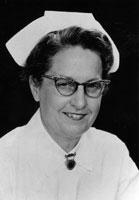 Mary Richmond’s nursing career spanned 50 plus years of dedicated commitment to excellence in nursing education and practice. A native of Vancouver, she finished high school in 1937. The Depression was still present and meant university was out of the question. She spent two and one half years as a volunteer in the Canadian Youth Congress before entering nurses training. Her life and career were shaped by this early experience. In her words “I believe that being a ‘nurse’ means serving on community boards to help people recognize our broader concerns for a healthful environment. This service confirms the nurse as citizen”.
Mary Richmond’s nursing career spanned 50 plus years of dedicated commitment to excellence in nursing education and practice. A native of Vancouver, she finished high school in 1937. The Depression was still present and meant university was out of the question. She spent two and one half years as a volunteer in the Canadian Youth Congress before entering nurses training. Her life and career were shaped by this early experience. In her words “I believe that being a ‘nurse’ means serving on community boards to help people recognize our broader concerns for a healthful environment. This service confirms the nurse as citizen”.
Mary graduated from the VGH/UBC program in 1945. She began her professional career teaching anatomy and physiology to nursing students at the Vancouver General Hospital (VGH). She obtained a teaching diploma from McGill University and later in her career taught for a period of four years at McGill University. She was the director of nursing education at Royal Jubilee Hospital (RJH) in the 1950s and during her tenure she taught anatomy and physiology to numerous RJH students. She is most remembered for the neurology lectures she based on her nursing experience at the Montreal Neurological Institute. She is also remembered for her demanding lectures and exams in Materia Medica. In her role as director of education she helped start programs in public health, Tuberculosis nursing and psychiatric nursing.
In 1964, Mary returned to the VGH to serve as director of nursing until 1973. During this time period she served on and chaired the Canadian Nurses Associations’ (CNA) National Committee of Nursing Service, as well as chairing the Western Canadian Board of Review in connection with CNA’s pilot study on the accreditation of schools of nursing in Canada. She was also active in forming the Council of Hospital Schools of Nursing, a committee of representatives from all the nursing schools in B.C., which in 1967, recommended that the training of nurses should take place in the post-secondary educational system. In addition, she served on an ad hoc committee on nursing research set up by the CNA. Mary was a charter member of the Canadian Nurses Foundation.
In 1974, she moved on to undertake two concurrent jobs in Victoria; administrator for a number of departments at the RJH in Educational Resources and consultant, adjunct professor and Acting Director of the University of Victoria’s (UVIC) School of Nursing. With the transition of hospital-based programmes to community colleges, Mary also served on the committee that saw the formation of Camosun College’s School of Nursing. At this time she also involved herself with the Registered Nurses Association of B.C.s’ (RNABC) Oral History Project and later helped enlarge this project to form the History of Nursing Professional Practice Group.
Although she relinquished her duties at the RJH in 1982, she continued to teach at UVIC as a visiting professor until 1988 and as Acting Director of the School of Nursing until 1992, when she retired from nursing. Her career and life accomplishments have been honoured with numerous awards. She was awarded an honorary Doctorate of Laws degree during the University of Victoria May convocation in 1991. In 1993 she was recognized for her contribution to the profession by RNABC highest award, an Award of Honour.
Mary was active on a long list of volunteer organization such as Swan Lake Christmas Hill Nature Sanctuary and the Royal B.C. Museum’s Fannin Foundation, reflecting her love of nature and natural history. She contributed to health related organizations such as the Cubbon Adult Day Care. She was a founding member of the B.C. History of Nursing Group of RNABC. She was a dedicated walker and faithfully found time daily for a five-kilometre walk.
Mary was loved and revered in her final years by family and friends. Her legacy to her family, where she was known as ‘our Mary’, was her gift of a love of nature, poetry and literature. Her legacy to her students and colleagues was her influence as a role model for excellence in nursing education and practice. She died November 29, 2002.
Provided by the B.C. History of Nursing Society